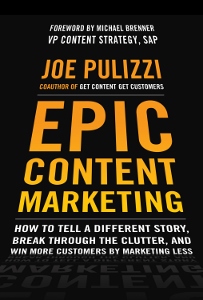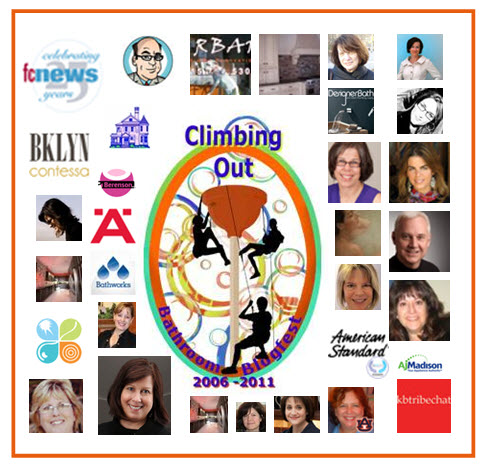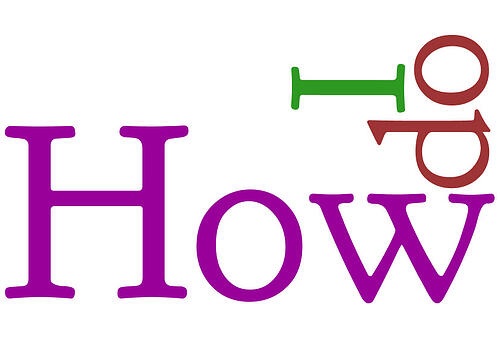 Do you have questions about applying social media marketing to your business?
Do you have questions about applying social media marketing to your business?
You've come to the right place! This "How Do I?" series is based on questions that have come up in conversation, during presentations and in one-on-one consulting sessions.
How Do I Social Media Marketing Series Table of Contents
How Do I Start With Social Media?
How Do I Evaluate A Blog?
How Do I Listen With Social Media?
How Do I Develop Social Media Guidelines?
How Do I Craft a Blog Welcome Post?
How Do I Create LinkedIn Group Guidelines or Rules of Engagement
How Do I Create Facebook Fan Page Guidelines or House Rules
How Do I Deal with Negative Comments?
How Do I Prepare For Social Feedback?
How Do I Make Social Media Relevant to Categories Like Flooring or Tile?
How Do I Create Content?
How Do I Do Twitter?
How Do I Do a Twitter Chat?
How Do I Increase My Social Media Network Followers
.jpg?width=500&name=Social-Drawing-twenty20_4a0ad8e6-9d20-4a6c-b5fd-6974b8da84fa%20(600x400).jpg)
How Do I Start With Social Media?
There's plenty of hype and buzz out there about social media, social media networks and social media marketing. It's part of politics, entertainment, breaking news, trends tracking as well as business.
Putting Social Media Marketing into Perspective
I like to start by putting social media marketing into perspective. We sometime forget this, but markets are conversations - a statement from the 1999 book called The Cluetrain Manifesto. Through conversation, buyers and sellers exchange information; they have the opportunity to develop trust and build credibility. Conversations set the stage for loyal communities based on shared experiences and stories.
Conversations take place between people, not between brands or companies. Not too different from how business used to be conducted before the days of mass markets.
Conversations are intrinsically social.
The tools of social media - e.g, Blogs, Twitter, Wikipedia, Flickr, Amazon reviews, LinkedIn, Facebook, YouTube, etc. - facilitate these intrinsically social conversations. These tools are easy to use, mostly free, and they encourage conversation, interaction over common interests, and the sharing of value through relevant content.
The tools aren't going away. They may morph, but the principles remain and affect us all. They enable us to strengthen connection, build trust and develop authenticity. They are certainly critical to establishing a digital presence.
Getting started is about taking small, thoughtful steps, say 15 to 20 minutes per day. Thoughtful in that you want to step back and consider how on target your efforts were after each short session. That allows you to recalibrate and avoid getting sucked into the fire hose of information.
You need to start, though, and be consistent about your personal explorations.
Start by Exploring Blogs
Blogs are user friendly. You can discover them via Google search without being overwhelmed with the firehose of content Twitter, Facebook and other networks serve up.
Through blogs, you will uncover thought leadership as well as leads to other resources. Blogs represent home base for other activities taking place on Twitter or Facebook, for example, and will help you make sense of those other networks.
- Start with a topic that interests you or relevant industry terms. You may refine your terms as you discover more.
- You may come across interesting resources listed in blog sidebars. They will be sources to other links and blogs worth exploring.
- Once you find blogs of note, subscribe to them.
As you start to explore, you will discover communities around related blog topics, and ideas worth sharing with customers, peers and friends. And possibly even worth commenting on!
How Do I Evaluate A Blog?
How Do I Evaluate A Blog? is a topic I address whenever I discuss the tools of social media and exploring what's out there.
What is a blog?
A blog is a web-log or an online journal with frequent articles on related subjects. A blog does not refer to the individual articles; those are blogposts or blog articles.
You'll notice that the most recent blogpost or article appears first, that -usually- you can leave comments at the end of each post, making the content interactive and social, and that content is searchable.
Blogs are relatively easy to get started with. Popular platforms include Blogger and Wordpress. Some are part of more sophisticated content management systems, such as HubSpot. Some are free, some have costs associated with them.
For a standalone blog, that is one that isn't either on a subdomain (e.g., blog.domain.com) or a directory (domain.com/blog), you may notice that the blog URL includes a reference to the blog platform (e.g., the 'blogspot' in my first blog http://FlooringTheConsumer.blogspot.com refers to Blogger) and some (e.g., https://www.simplemarketingnow.com/content-talks-business-blog) don't.
In terms of evaluating a blog's content worthiness, where or how you publish the blog is irrelevant.
Quality Matters in a Business Blog
What does matter is the quality and credibility of the content on your blog.
As easy as it is to start blogging, determining purpose and strategy for the blog and its content - planning for it, organizing it, researching it and writing it in a compelling manner - takes considerable commitment.
A business blog is a "self-publishing platform." It is your means for publishing content that you create; it's like having your own printing press.
As with any book or magazine or newspaper that a printing press generates, if the content isn't compelling or relevant, no one will read what you have to say. If it is, then people you have never met before will find your content and start to engage with it and you.
However, not all blogs are created equal and here's how to go about determining whether a blog is credible and worth exploring.
1. The Blog Sidebar
Not all blogs have sidebars. However, if there is one (this is the column alongside the main body of text. It can be on the left or right), check to see what you have there.
If this is a standalone blog, look for information about the blog author and its mission.
Do you see archives, category topics and links to additional resources? The archives give you a sense for how actively managed or nurtured the blog is. From the categories you'll know more about the blog's themes and subthemes.
Look, too, for a way to subscribe for updates.
2. The Content of the Blog
As you examine a blog's content, look for relevance. Are the various articles thematically related? What type of content do you see? Is there constant self-promotion or is this thoughtful observation and analysis? Do you notice links to outside references and perspectives?
Evaluate how well written the blog is in terms of idea development and flow. Does the flow make sense?
Blogs are more conversational than other parts of a website. Does the content read like a marketing brochure or is it conversational and more like a letter from a great friend?
What is the tone of the content? Is the 'voice' stiff and distant or is it relaxed? Does humor come through?
3. Blog Images and White Space
As with all web content, you need to make sure your blog articles make for a user-friendly experience on mobile devices as well as on desktops.
The best solution is to ensure plenty of white space - use bullets, short paragraphs - and help your reader by making good use of headers and subheaders.
Also use visuals!
At the very least an anchor image for each article that relates to or adds dimension to your content and more to break up the columns of words and add some eye-candy. As relevant, embed a video or a Slideshare, include an infograpic or add screengrabs.
4. Blog Comments
Comments are wonderful, but judging a blog's worth based on the number of comments doesn't always lead to the right conclusion.
The number of comments a blog receives depends on the topic, the industry as well as the audience. You may discover conversation about your blog articles happening more privately via email or in person, or even on social networks where you have posted a link to the article.
How Do I Listen With Social Media?
Listening comes up repeatedly in social media marketing. You see, the tools of social media don't really work if you don't listen. Or, at least, they may work in a traditional and not very social way. In which case, social media marketing isn't really taking palce. So listening is critical.
If markets are conversations - rather than one-way monologues - then you must consider what the other party has to say. You may put forth your perspective, but you must then listen to the response and be ready and willing to come up with a solution or improvement and definitely an acknowledgment. That give and take is what leads to engaging with readers, visitors and customers and eventually forming a community. It is what leads to developing trust and credibility.
Listening is hugely under appreciated, particularly in traditional marketing. We might listen at arm's length via a focus group, but not up-close-and-socially.
Luckily, it isn't difficult to start to listen to the conversations. And, it isn't that scary either!
Social Media Listening Tools
Start with the most basic and flexible tool available: Google alerts. Set up alerts for your name, your company, your brand names, your competitor names, subjects and topics that interest you... It costs nothing.
Explore terms and subjects of interest at a search window first so you can validate that you are getting the kinds of results that interest you. Then, refine.
Where you aware that you can search in Facebook? Try it. You'll definitely find it interesting and you may be surprised by what you find.
Don't forget YouTube, the world's No. 2 search engine.
Finally, Twitter. You don't have to have a Twitter account to search Twitter.
Social Media Listening Guidelines
Listening leads to insights. You want to tread carefully, though, as you enter into the world of those you want to listen to. Social media interaction is often described as the equivalent of entering into a living room or a kitchen where conversations are in progress. You can't just barge in and take over.
Definitely listen with social media, respectfully, intensely, authentically, open-mindedly, creatively and simply. Beware of too much baggage; it might prevent you from hearing the obvious.
Other Social Media Listening Tools
Don't forget about using online survey tools, generating discussion on your blog, participating in forums, and simply asking questions and listening to the responses.
>> Read How to Create a Social Media Listening Strategy

How Do I Develop Social Media Guidelines?
You're ready to get started with social media marketing. You've gone through intense soul searching and decided that engaging with existing and potential customers and sharing valuable, relevant content with them on an ongoing basis is the way to go.
An important next step, particularly for a corporate or business blog, is developing social media policy or guidelines.
Why Social Media Guidelines & Policies?
Social media guidelines force you to think about scenarios and let you anticipate responses. They allow you to set expectations for behavior and interaction - not too dissimilar from the rules your parents established when you were a kid.
Social media policy and guidelines fall into two camps:
- Internal guidelines
- External or comment policy
Internal Social Media Guidelines
Internal social media guidelines mean that everyone in your organization will understand what can be discussed in a public forum and what can't, and how to behave in such a forum: transparently, responsibly and consistently.
External Social Media Guidelines
From an external perspective, guidelines let your readers know what to expect on your social media site: what kind of discussion will you encourage, how you handle comments [are they moderated?], what about product complaints or transactional issues, whether your response will be timely...
They can be referred to as 'house rules' or a 'comment policy.' You might see them in a Welcome blog post, in the about us section of your social network, or included in the management section of a group.
These guidelines set the stage for interactions. They are the equivalent of welcoming someone into your home or store or classroom, offering an overview of where things are and explaining a few rules [i.e., please leave your shoes as the door; here is the lay of the land; please don't interact with the students...].
Crafting Social Media Guidelines
In preparation for creating your own social media guidelines, you'll find it helpful to absorb how other organizations have approached theirs. Not all of what they include may be relevant to you, but their guidelines may remind you to address an area you hadn't considered.
Here are ideas relating to internal and external social media policies.
- This Mashable article about 10 Must-Haves for Your Social Media Policy. It includes a video clip of Barry Judge, CMO of Best Buy, explaining how increased transparency and trust provide value to customers. The means to this: the tools of social media. The post also includes a sample internal social media policy.
- Check out Intel Blogs
How Do I Craft a Welcome Blog Post?
Once you've established your social media guideliness, you can craft a Welcome blog post.
One approach is to 'feel' the conversation space that your blog represents. Is it a living room? More of a kitchen table, a backyard BBQ grill? Or, perhaps a cozy fireside chat? Note that these are all places where conversation takes place.
Start, then, with a greeting. If your blog [or other social media marketing platform] is to be a conversational setting or virtual third place for gathering, how might you greet or welcome visitors? What should newcomers know about? What about those who have been coming for a while? How do you get the two groups to interact?
Describe how the concept for your blog came about. Was it the result of a conversation? An Aha! moment? What was the impetus for wanting to create a social media beachhead and commit to it and to the conversation that you hope develops?
Next, offer a 'tour' of your space. Will others be contributing or is this your sole space? What topics will you address? How do they relate to the overall purpose or vision for your blog? Do you anticipate any recurring series ideas? Expect things to evolve over time, but think about how you are adding value to your audience.
You should definitely address the 'fine print' or your social media policy or guidelines and set expectations for behavior. If you prefer not to include this in your Welcome post, make it your second post. It's critically important to address how will you interact, what's on topic and off-topic, whether any topics are confidential, will you moderate comments, would you rather have specific customer issues addressed elsewhere, and how do your social media platforms relate to those existing customer service platforms...
>> See Have You Written a 'Welcome Readers' Blog Post or Article?
How Do I Create LinkedIn Group Guidelines or Rules of Engagement?
Have you given thought to your LinkedIn Group Guidelines or Rules of Engagement? It's an important question, and yet one that many group owners, managers and moderators haven't addressed.
Many LinkedIn Groups aren't that vibrant and others, too self-promotional. The ones that shine are ones where the group owner and managers actively moderate, invite conversation and encourage the sharing of true value with members.
Here are two examples to inspire you.
HIMSS LinkedIn Group Guidelines
An impressive model for LinkedIn Group moderation, interaction and guidelines is HIMSS, the Healthcare Information and Management Systems Society, which has successfully grown a LinkedIn Group to over 180,000 members by nurturing interaction, carefully moderating and consistently communicating its guidelines.
Please read the following rules of engagement before posting. They are designed to ensure the HIMSS Group remains professional, vibrant, and useful for all group members. Since there are gray areas for such rules, HIMSS Group moderators reserve the right to interpret the rules of engagement so the group can successfully lead change in the health IT and management systems field through knowledge sharing and communications. Although, HIMSS staff moderates the group, members are encouraged to help the moderators in this process by reading and following the Rules of Engagement, flagging inappropriate content and inform a moderator of spam and inappropriate content.
Lead Change LinkedIn Group Guidelines
And another from Lead Change:
The purpose of this group is to connect and discuss character-based leadership. You will notice that self-promotion is generally ignored. People in this community connect and share openly about leadership, but if all you do is talk about yourself, people will lose interest quickly. Promoting other groups or services that don't have to do with leadership development will cause us to move your discussions to the Promotions area, or ban you altogether.
How Do I Create Facebook Fan Page Guidelines or House Rules?
If you have an active Facebook fan page for your business, you should consider creating and posting guidelines or house rules for the page.
Intel's Facebook Fan Page House Rules
Welcome to Intel’s Facebook page. We’re glad you are here.
This page provides a place to discuss the Intel brand, our family of products, initiatives, services and breaking news. The following guidelines are designed to help provide a quality environment for our fans. Please take a minute to read them and keep them in mind whenever you participate.
By using or accessing this page, you agree to comply with Facebook’s Terms and Conditions. While we are excited to hear from everyone, it is important to note that postings by fans to Intel’s Facebook page do not necessarily reflect the opinions of Intel, nor does Intel confirm their accuracy.
We understand that technology is a subject many of you are passionate about – a passion we share. We welcome all questions and commentary, including constructive feedback. We don’t take decisions on moderating posts lightly. But we do expect that participants post content and commentary that is both relevant and respectful to this community as a whole. Intel reserves the right to remove any posts that don’t adhere to our guidelines and to block anyone who violates them repeatedly. Specifically, we do not tolerate these kinds of posts:
• Abusive, harassing, stalking, threatening or attacking others
• Defamatory, offensive, obscene, vulgar or depicting violence
• Hateful in language targeting race/ethnicity, religion, gender, nationality or political beliefs
• Fraudulent, deceptive, misleading or unlawful
• Trolling or deliberate disruption of discussion
• Violations of any intellectual property rights
• Spamming in nature
• Uploading files that contain viruses or programs that could damage the operation of other people’s computers
• Commercial solicitation or solicitation of donations
• Link baiting (embedding a link in your post to draw traffic to your own site)
If you have a customer service issue, we recommend visiting http://www.intel.com/p/en_US/support or sending a tweet to http://twitter.com/intelsupport for the fastest paths to resolution.
View Intel Online Privacy Notice Summary: www.intel.com/privacy
Urban Outfitters' Facebook Fan Page House Rules
Does that sound like a contradiction? How about this: Urban Outfitters is the biggest small retailer in the world.
Still confused? That’s because we didn’t start Urban Outfitters to make sense on paper and we certainly never thought we’d be writing something like a brand bio.
Hell, we don’t even have a logo.
Questions about your UO order? Feel free to send us a message! We’re here to help.
The Urban Outfitters Facebook page is intended to be a fun community page where fans can learn about new styles, upcoming events, promotions and more. We encourage fans to share thoughts and opinions on Urban Outfitters’ social channels with the expectation that they will do so in a respectful manner. UO reserves the right to remove inappropriate posts, including those that are: (a) abusive, defamatory, threatening or obscene; (b) fraudulent, deceptive, or misleading; (c) in violation of any law or regulation; or (d) offensive, either graphically or in tone. Repeated violations of the Urban Outfitters comment policy may cause the author to be blocked from Urban Outfitters’ social media.
The U.S. Army's Facebook Fan Page House Rules
Welcome to the official U.S. Army Facebook page where you will find news coverage, videos and photos highlighting our Soldiers around the globe.
While this is an open forum, it's also a family friendly one, so please keep your comments and posts clean.
You participate at your own risk, taking personal responsibility for your comments, your username and any information provided.
Comments and posts that violate any of the guidelines listed below may be removed:
• Do not post graphic, obscene, explicit or racial comments . We also do not allow comments that are abusive, hateful, vindictive or intended to defame anyone or any organization.
• Do not post any solicitations (i.e.: asking users to "like" your Facebook page, visit your website, sign a petition, contribute to a fundraiser).
• Do not post advertisements, prize contests or giveaways. This includes promotion or endorsement of any financial, commercial or non-governmental agency. Similarly, we do not allow attempts to defame or defraud any financial, commercial or non-governmental agency.
• Do not post details about an ongoing investigation or legal or administrative proceeding that could prejudice the processes or could interfere with an individual's rights will be deleted from this page.
• Apparent spamming or trolling will be removed and may cause the author(s) to be blocked from the page without notice.
• Do not post copyrighted or trademarked images or graphics. Imagery posted on the Facebook wall should be owned by the user.
• Do not post comments, photos or videos that suggest or encourage illegal activity.
• Do not post political propaganda.
• Do not post documents of any kind.
• All information posted to social media sites will be unclassified. No FOUO (for official use only), classified, pre-decisional, proprietary or business-sensitive information should ever be posted or discussed on this page. Don’t post personnel lists, rosters, organization charts or directories. This is a violation of privacy.
The appearance of external links or the use of third-party applications on this site does not constitute official endorsement on behalf of the U.S. Army or Department of Defense.
For more information, visit the DoD Social Media user agreement: http://www.defense.gov/socialmedia/user-agreement.aspx.
You are encouraged to quote, republish or share any content on this site on your own blog, Web site or other communication/publication. If you do so, please credit the Army unit or the person who authored the content as a courtesy.
How Do I Deal with Negative Comments?
One reason for going through creating social media guidelines - especially external ones - is to think through scenarios and how to respond to the unexpected, including negative comments.
The question comes up given the increasing importance of digital reviews via Google, Facebook, Yelp, Amazon and other platforms. These sites offer social proof about your trustworthiness. They are digital word-of-mouth endorsements.
Yet, there's a concern that, by allowing comments, feedback, ratings & interaction, you open floodgates of negative feedback...
Now, although negative comments happen, they happen less frequently than you think. And, when they do, they aren't necessarily all bad.
The Benefit of Negative Comments
Your willingness to consider different perspectives makes your social presence and content much more believable. Furthermore, showing acceptance of different opinions communicates that you are open to constructive exchanges. It means you are listening.
Negative reviews make positive reviews more credible.
Your response to negative reviews demonstrates how your business operates.
Negative feedback can trigger improvements that everyone benefits from.
People are already talking about you. Wouldn't you rather hear what they are saying and have a chance to participate in that conversation? You might actually learn from the experience and improve your business or offering. Those conversations are the equivalent of research sessions with your most passionate customers...
Consistency Matters for Customer Feedback
Keep in mind that how you respond to customer feedback on social channels needs to be entirely consistent with how you respond in person, over the phone and via email. From your customer's perspective, these are all ways of interacting with your business.
Best Practices for Responding to Negative Feedback
- Don't get defensive.
- Closely monitor your social channels. An unhappy customer may post a similar complaint on multiple networks until you respond.
- Don't ignore the feedback. Acknowledge.
- Take the conversation offline as quickly as possible for resolution.
- Use common sense.
Ideally, you have an active presence online, regularly encourage reviews and acknowledge the feedback. That ongoing positive history documenting how satisfied people are with you is the most effective way to counter occasional unhappy comments online.
How Do I Prepare For Social Feedback?
Let's talk a little more about social feedback and how to prepare for it.
As mentioned above, the prospect of negative comments can be scary and possibly even unpleasant. But feedback is gold. It indicates that someone is paying attention and cares enough about you to take precious time and communicate with you. That effort, though, comes with expectations about your response. How best to prepare yourself?
Start by Focusing on Your Customers
The best starting point is to focus simply on your customers or readers and determine what do you want to accomplish with them?
Do you intend to sell them something? Educate them? Build a relationship? Exchange ideas?
Next, List your Customer Communication Channels
Think about all the channels you have available for communicating with your audience: telephone, email, website, social channels, in-person.
What kinds of conversations are already taking place [sales, problem resolution, education, relationship-building, ...]?
Are you consistent in your customer messages across those channels and those conversations?
Consistency is critical because the channels themselves are irrelevant to your audience. Regardless of how, customers expect to reach you, they expect you to acknowledge and that you will interact consistently.
Then, Review Your Social Media and Customer Service Guidelines
This is where guidelines are invaluable, internally to reach consensus across functions, roles, locations, etc. on how to respond, the frequency of response, and the consistency of response, as well as externally so your audience knows what to expect from you.
Worst Case Scenario Planning
Think through your worst case scenarios and how you would respond.
Ignoring the situation isn't an option. Instead, you'll need to:
- Be proactive
- Act quickly but cautiously
- Be simple, consistent and honest in the message you communicate.
- Be human
Please don't create fake reviews or news.
Customers expect a response. If they don't get it, they have reason to resort to more public forums to force a response. The lesson: be listening, be paying attention and be ready to respond consistently. The social feedback you receive is rich and conducive to insightful conversation, but you must be prepared and willing to welcome it.
Remember, too, that online despite being part of sometimes large businesses, social interaction is still about interacting with people. When you engage socially you do so as an individual wanting to interact with other individuals. Mistakes happen. If you remember that we're 'all in this together', you have the opportunity to learn from mistakes and strengthen relationships.
How Do I Make Social Media Relevant to Categories Like Flooring or Tile?
Is social media relevant to a category like flooring, or tile or another with a long purchasing cycle? If customers are in the market for a product on average every 5 – 7 years, what kind of conversation might you have with customers and how does it result in additional business for me? Do you get a meaningful return for that effort?
The response is that social media is definitely relevant to complex categories like flooring or tile, as well as most B2B solutions, which have a long repeat purchase cycle and represent a significant investment.
Here are three assumptions worth spelling out.
- One is that you consider that your business is about more than just a one-time transaction.
- The other is that you really care about your customers and appreciate that your product or service fits into their bigger picture -- think home, lifestyle, business, community or general environment -- and enables them. [Isn't flooring a support base for living?]
- And, you must believe that loyalty is a driver of profitability.
Social Media Allows you to Educate
Complex products require education. What better way to educate than by using social media?
Building relationships with customers uncovers opportunities. Despite the long repeat purchase cycle, how can any retailer know that a customer looking for one solution doesn't have other similar decisions waiting to be made?
Traditional tools combined with social media tools like Google local ratings and rankings would help you hear about unhappy situations. By hearing about them, you have the opportunity to fix them. By sharing this information in a public forum, you communicate to future customers how seriously you take customer satisfaction! Blog comments offer a similar forum for communication. Or, invite customers to be part of your e-Newsletter list or Facebook page to communicate directly with them.
Including How to Maintain Your Products
Caring for and maintaining your products is a natural education topic.
As complex and significant the investment, many products - including flooring - rarely come with detailed care instructions. In many cases, how a consumer maintains [or doesn't] her purchase may invalidate a warranty.
Although you will find care information online, much of it is confusing and not always credible. Imagine the opportunity available for strengthening relationships and building loyalty by offering customers and visitors a wealth of reputable flooring care tips and recommendations for maximizing the original investment.
This can be accomplished via your website, a blog, Facebook and also video clips [e.g., check out this video of Annette Smith demonstrating how best to remove a carpet stain].
There's more! Implementing a social media strategy for complex categories allows you to:
- Learn from your customers, anticipate what they need, conduct research with them and enlist them for product development. Fiskateers comes immediately to mind.
- Connect with customers you never realized were in the market for your products. Look at the innovation that museums are implementing to connect with customers.

How Do I Create Content?
Understanding how to create content is at the heart of participating in social media marketing.
Content allows you to develop visibility for your business. It enables you to tell your story, share it on social networks and connect with online visitors.
Many organizations, including small businesses, don't know how to manage let alone create new and engaging content that connects with potential online customers.
Start with your Website Content
Make sure your content is yours and yours alone. Even if you are discussing basic information about product, make sure it's written in your own words, especially if you are an independently owned business, even if you are affiliated with a national buying group.
People want to buy from people. So offer them content written by people with specific people in mind. It's more believable; it's simpler and it alleviates frustration.
Communicate your Story
Communicate information about who you are, how you got started in the business, what makes you special, and nitty gritty details about your business [i.e., hours of operation, address, phone numbers...]. Include pictures of your business owners and milestones.
Show signs of life - that your website is up-to-date and that you are adding new and relevant information. Include press releases; they indicate that you're up to something in the marketplace and that you're excited about what you're doing.
Show a more casual and personable side of your brand on your blog. That's where your story comes alive on an ongoing and frequent basis via marvelous relevant content. Include perspectives from your employees, suppliers, how you care for your customers, new product arrivals, local community events you're involved in, customer success stories,...
And, although you may from time to time mention promotions and sales, your content should not limit itself to that kind of hard sell that is considered the equivalent of shouting at people -- and will be ignored.
Your goal is to share stories that engage with readers, that are relevant, that have meaning.
Share your Story on Social Networks
These content principles - unique, fresh and consistent content that tells a story relevant to your readers and doesn't shout - hold for other digital communication tools like Twitter or Facebook. Fresh, relevant content sets the stage for building a relationship with visitors.
You may think that you couldn't possibly come up with enough fresh content. You would be surprised at how much you can come up with!
It's a matter of loosening up your thinking, shaking off your blinders and intensely considering who you want to connect with. If it's people who share your passion for an area or a subject, then what comes to mind? Can you involve others who think similarly? If not to develop content with you then to help validate ideas and offer perspectives.
How Do I Do Twitter?
Twitter is a free, micro-blogging platform. Micro because you have 140 characters to communicate a message of your choice.
The primary audience for your 'tweets' [i.e., your micro-blogposts] consists of your followers - other folks with Twitter profiles or accounts who have decided to subscribe to your 'Twitterstream' or series of tweets. The secondary audience is the world, assuming your message appears in a Twitter-based search.
Twitter is mainstream now. You hear it mentioned during network news, in politics, entertainment and more.
Although you'll find plenty of inane tweets about what someone had for breakfast [in response to the Twitter question: What are you doing?], it's worth exploring the platform to experience for yourself what all the buzz is about.
Get Started with Twitter
- Go to Twitter.com and register.
- Create a profile; upload a photo of yourself [yes, you really need to include a photo] and give it a try. Your twitter handle with be something that starts with @ [mine is @cbwhittemore].
- Give yourself time immersed in the medium before making up your mind.
- Visit http://search.twitter.com and enter in some terms. Try keywords, brand names and #hashtags; enter your own twitter handle, with and without the @; what are the hot topics being discussed. See what appears.
As you explore, you'll notice interesting trends of interest to you.
- Some of your Twitter peeps are fantastic about capturing conference highlights via Twitter. To follow what happens at a conference you can't attend, try finding the 'hashtag' corresponding to the event.
- Some participate in regular Twitter Chats that you can follow if you know the relevant # to use.
- New people to follow.
Increasingly on Twitter, you will discover stories and blogposts worth reading based on people's tweets. Part of doing Twitter (and social media) right is sharing with others. Sharing information or links or humor or wisdom.You'll notice that links are compressed into 'tinyurls' [visit Tiny Url and try it for yourself; then cut/paste into Twitter] to not hog up all 140 characters+.
As with most digital marketing tools, it's worth your while to learn more about them, how they work, and how people share value with their followers.
Set up your account, explore and dedicate 15 to 20 minutes per day experimenting. Investigate whether your customers might be participating. If so, can you engage with them and offer value?

How Do I Do a Twitter Chat?
Have you heard about Twitter Chats?
They take place on Twitter, on a recurring basis - e.g., often weekly although there are a few exceptions, on the same day and time of the week and address a set subject area. Although the theme will vary from chat to chat, if you are participating in a travel-related chat [e.g., #TNI - travelers night in], participants will have some connection to travel; if it's a horse chat [#horsechat], it will have something equine to it.
Each Twitter Chat is identified by a hashtag [e.g., #] and the name of the chat.
When you participate in a chat, you create a search [via http://search.twitter.com or with a new search column in Hootsuite] on the specific hashtag that identifies the Twitter Chat you want to participate in. As a result, you filter for Tweets related to that event. When the chat is over, you close the search.
Twitter Chats allow you to share a common interest with those participating. As a result, you encounter people whom you will want to follow on Twitter. And vice versa.
In terms of participation, you may decide to simply watch and learn the first time. Or, you may just dive in and ask questions. Each chat has its own personality.
>> See Bathroom Blogfest Twitter Chat: #kbtribechat
>> See Tile Industry at Coverings 2012 via Tweetup, Twitter Chat, Trends
How Do I Increase My Social Network Followers?
You may be wondering, if social networks are so important, how can you increase your followers?
Especially since you are constantly reminded how many followers you have, who your new followers are, how engaging your content seems to be and that boosting or paying for additional traffic is the way to go.
The pressure is intense to build quantity.
Don't forget about quality. You want to build a community of fans who believe in what you do and value it.
Engage with your Followers, Fans and Subscribers
An easy answer is that you can increase the number of followers, fans and subscribers by engaging with them. Say thank you; get to know them; acknowledge them; be respectful; offer them content that addresses questions they have about your product or service. Imagine if your fans, followers and subscribers came by your office, store or home. Wouldn't you greet them and invite them in for conversation? It's the same online.
That has limited benefit, though, as social networks have become the new mass media.
Beware of Buying Traffic
Be cautious of 'get rich quick' schemes that guarantee you 1000s of followers and fans overnight.
The result may be good for your ego, but it will not deliver quality of interaction, the possibility of building credibility online and the opportunity to establish long term business relationships over the long haul.
It will, however, offer you considerable spam and irrelevant messages. Much better to build your base of fans, followers and subscribers consistently over time as a result of exchanging value and meaning. This will also support any kind of paid social programs you participate in.
Remember your Goal for Social Media Interactions
Always have a goal when it comes to building traffic. Know why you are doing things.
If you intend to pursue paid social to increase your followers (which now is the only effective way to do so), be sure to remember what your goals are. Otherwise, you may spend a lot of effort with little to show.
Keep in mind:
- You do not own your social media properties.
- As wonderful as building social followers may seem, better to push people to your website and encourage them to sign up for a newsletter so you can 'own' their contact information and have permission to communicate with them beyond that social network.
- Determine what success looks like up front.
Ultimately, the most effective ways to build your community drive people to your site to subscribe to your blog or your newsletter. You can do that effectively by,
- Being active with your communities
- Writing about what you love and doing so with insanely great content.
- Answering questions for your audience.
- Offering real value.
- Delivering as promised
- Being there for your readers.
- Providing new insights
Questions About Social Media Marketing?
What burning How Do I? questions do you have about social media marketing? Have we missed one? How are you looking to use social media marketing to improve your business? What are you struggling with?
This article was originally published on 7/14/2011 and has been significantly updated.








.jpg?width=500&name=Horror-twenty20_38a8b249-f3a8-4f03-990f-695ed839a923%20(650x435).jpg)
.jpg?width=500&name=Wood-table-spices-twenty20_53b719fe-c0c5-40e7-b9cf-0fd62adc0171%20(500x333).jpg)
.jpg?width=500&name=Mosaic-board-twenty20_35276084-a57e-4743-b0b1-f971375437dc%20(500x500).jpg)

.jpg?width=500&name=Fish-Net-twenty20_32921d08-521e-4400-9d0b-674a7e39ea8a%20(650x488).jpg)






